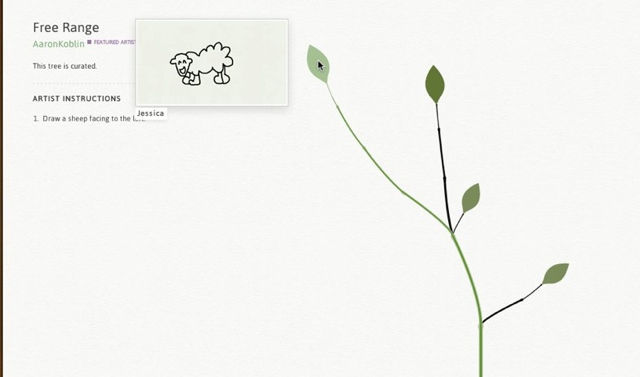With all this talk about the future of art being in browser windows and such, you might forget to ask the question – why? What will it actually look like?
Artist Aaron Koblin has been, perhaps more than any one artist, someone who has pondered what form art made by online crowds might take. His work has often revolved around data – the trails left by masses moving in the air, data set of Thom Yorke’s 3D face given to artists.
When the crowd is the source of that data, Koblin has uniquely walked the line between optimism and criticism. The micro-economies of crowd-sourced sheep drawings and paper currency are problematic, revealing the power of Internet-enabled creativity as well as the potential danger of globalized devaluation. Critics of Google, Koblin’s current patron and employer, might see Internet commerce even in bleak terms. Investors might wonder if the same economic engine could be an opportunity.
But politics and macroeconomics aside, something extraordinary has happened in Koblin’s collaborations with director Chris Milk. They’ve been propelled by advancing browser technologies that free the online page from antiquated restrictions. And above and beyond that, Milk and Koblin have begun to evolve a moving (emotionally and in the sense of animation) vision of the collaborative online space as art medium.
At times, the results have been simply sublime. Music wends its way across imagined 3D landscapes that seem to burst out of the dull, flat monotony of the average Web, or plot a course into the place you grew up. Johnny Cash comes to life through the eyes of his fans in heart-wrenchingly fluid form.
And now, that artistic form seems to present a plausible shared interface. In “The Exquisite Forest,” the seeds of one person’s animation can literally be seen branching into new forms and variations. In accelerated, transparent Web view, it’s a chance to see some of the essence of artistic transmission and collaboration. The seeds are notable – Tate Modern got in on the action, selecting artists from traditional animators to generative designers. But the real test will be the trees of online users’ work that result.
The Exquisite Corpse, of course, gives a frame for all of this. We see genetics and evolution as a theory by which crowd-sourced animated narrative might take shape. (It’s fitting, then, that in his own contribution, Aaron Koblin heads back to those sheep.)
The interface, the capabilities of the browser, and those animated seeds are already impressive. Now, we sit back and watch – or sit back and draw – and see what might happen next. Can the browser really drive animation in some sort of accelerated evolution? What will happen at the branches, the forking possibilities, and at the final animation that emerges from “natural selection.” (Well, user selection – you get to choose how these trees are grown, like a crowd-sourced horde of bonzai gardeners.)
I suppose one could ask the same question of the Web. And there, the technology isn’t just a showcase for Google, a whiz-bang tech demo. Yes, in the behind-the-scenes vid, Koblin is quick to hit the notes of Google’s accomplishments – App Engine, the cloud-based system by which authentication works and the back-end functions, Chrome and its formidable GPU-accelerated Canvas drawing, JavaScript coding, and Web Audio sound-production facilities. But what these things could offer is a chance to make sharing expression beyond words powerful and expressive.
For people who love to draw and make things move, you might hope this is just the first seed.
http://www.exquisiteforest.com/
